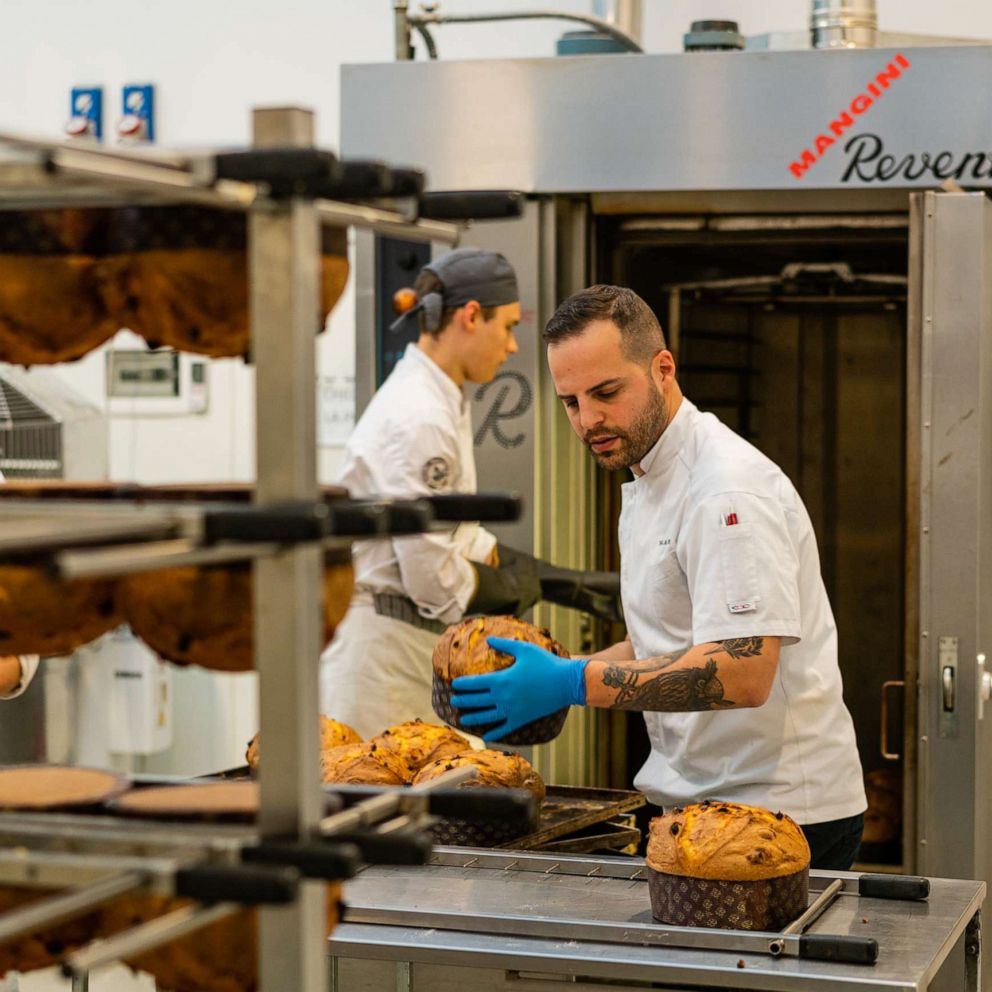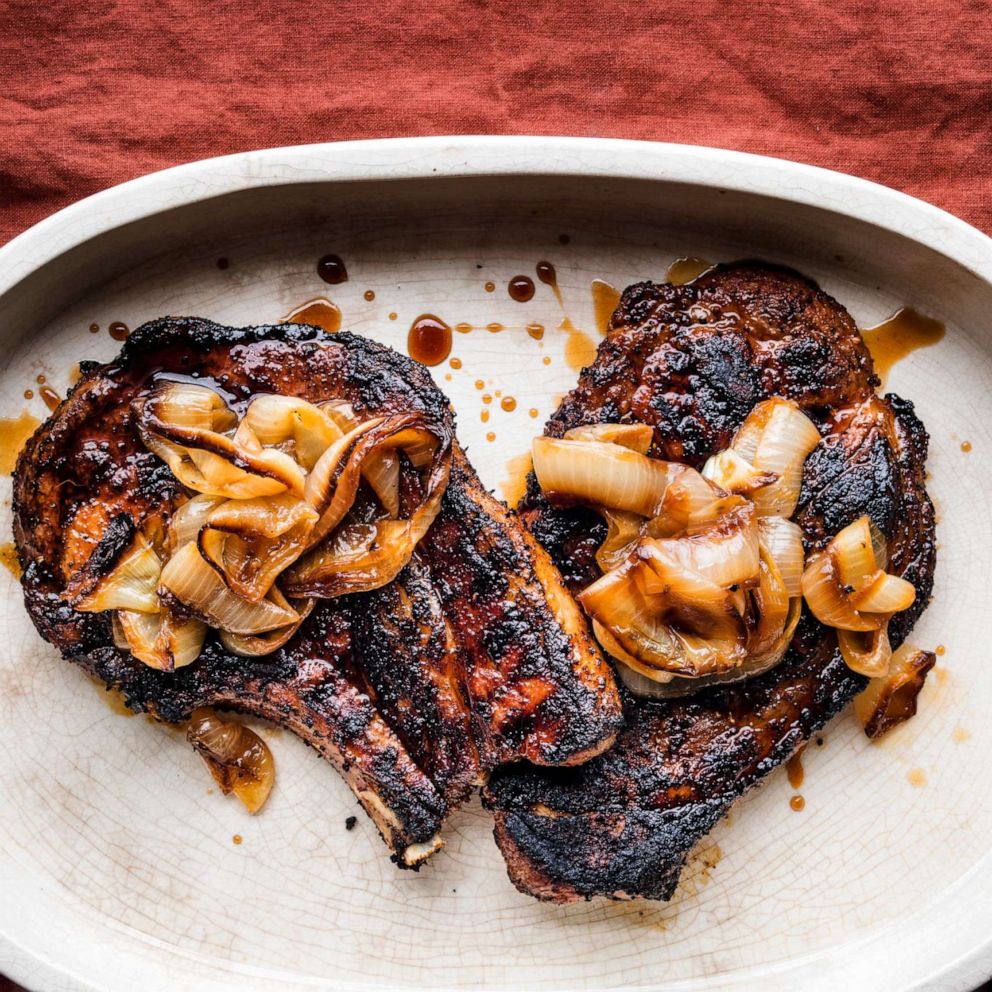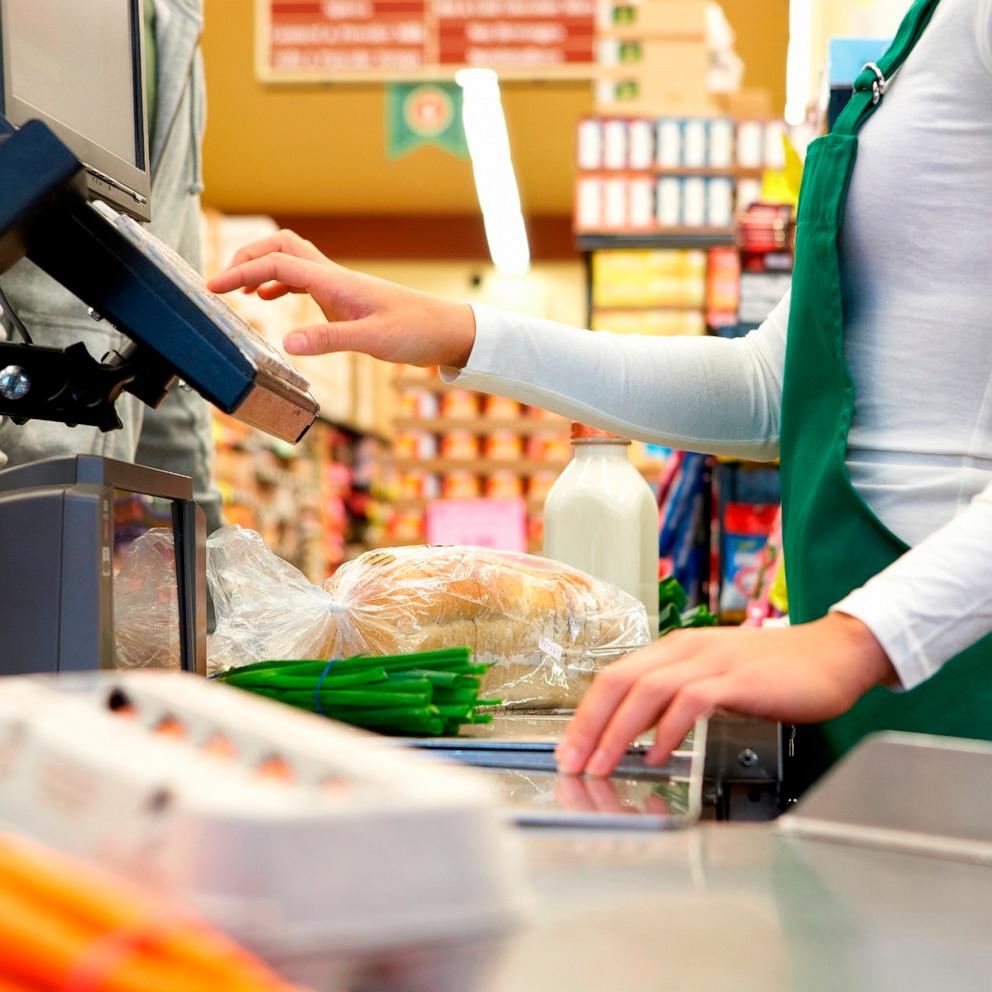Italian American recipes for homemade focaccia, malted tiramisu and more

From focaccia to limoncello layer cake, nothing quite tempts taste buds like fresh-baked Italian pastries.
Now, one master of the craft is sharing his tried and true techniques to help home cooks create a mashup of authentic Italian flavors with American innovation to achieve appetizing results without going to a café.
Renato Poliafito, owner of the popular Prospect Heights bakery and café Ciao, Gloria, joined "Good Morning America" on Tuesday in tandem with his latest cookbook launch for "Dolci! American Baking with an Italian Accent."

The collection of nearly 100 recipes, which already has stamps of approval from fellow culinary icons Lidia Bastianich, Nancy Silverton and Giada de Laurentiis, celebrates the flavors of la dolce vita from Bologna to Brooklyn.
The two-time James Beard Award nominee pays homage to pastries of the Old World and the New with his unique spin on sweet inventions like Malted Tiramisu, as well as savory recipes for Sourdough Focaccia.
While Poliafito has co-authored four previous dessert-themed cookbooks, he said he considers "Dolci" his first "solo album."
Below, check out full recipes from "Dolci!" to recreate at home.
Sourdough Focaccia Three Ways

Makes: 1 baking sheet of focaccia
"The focaccia at Ciao, Gloria is a godsend, if I do say so myself. Our recipe uses a sourdough starter, which is worth the effort for giving the bread that indelible tanginess that only comes from lengthy fermentation, which carb aficionados like myself deeply appreciate. If you don't have a starter going, there's a guide below to make your own; it just requires a little time, patience, and Sicilian witchcraft (or science). This recipe includes a trio of my favorite toppings, from simple to loaded, but feel free to experiment with the flavors you love. There's no shame in going heavy on the shredded cheese, pepperoni cups, and sliced mushrooms."
Note: If you don't want to go through the process of making your own starter, ask your local bakery if they have some to give. Most bakeries will be happy to share some with you free of charge.
Ingredients
225 grams (1 cup) sourdough starter (recipe below)
640 grams (4 1/2 cups) all-purpose flour
3 grams (1 teaspoon) instant dry yeast
65 grams (1/3 cup) good-quality olive oil, plus more for the dough
12 grams (1 tablespoon) fine sea salt
Directions
In a stand mixer fitted with the dough hook, combine the sourdough starter, flour, yeast, olive oil, and 425 grams (1 3/4 cups plus 2 tablespoons) warm water. Mix on low speed until combined, about 3 minutes. Add the salt, increase the speed to medium, and mix for an additional 3 minutes to continue to develop the dough. It will be very loose and sticky, do not fret.
Generously rub a baking sheet with olive oil. Transfer the dough to the baking sheet and pat into a rough square shape. Fold the dough over itself by lifting the edge farthest from you and pulling it toward you to fold in half. Turn the baking sheet 90 degrees and repeat this process until all four sides have been folded on top of each other. Cover the baking sheet with a kitchen towel and let the dough rest at room temperature for 30 minutes.
Repeat the folding and resting process two more times. After the final rest, stretch out the dough to reach all four corners of the baking sheet. If you are experiencing any snap back, cover the dough and let it rest for 10 to 15 minutes until pliable. Brush the top of the dough with olive oil and cover the entire baking sheet loosely with plastic wrap. Refrigerate overnight to rest.
The following day, remove the dough from the fridge and let proof for about 2 hours until bubbly and doubled in size.
About 30 minutes before the dough is done proofing, preheat the oven to 425 F and set racks in the center and lower third. Place a baking dish filled with 1 cup of water on the lower rack while the oven preheats. The steam will help create a nice crispy crust and chewy interior on the focaccia.
Discard the plastic wrap and dimple the focaccia with your fingers for the classic, undulating surface. Pop any large bubbles as those may blister and char, unless that's the look you're going for.
You can bake the focaccia as is: Top with flaky sea salt and a drizzle of olive oil and bake until dark golden brown, about 25 to 30 minutes, rotating the baking sheet halfway through. The plain version is especially great for sandwich bread. To take it to the next level, try one of these variations.
D'Oliva
Arrange marinated olives, homemade (recipe below) or store-bought, in the dimples of the dough, using as many as you'd like. Sprinkle some rosemary tips across the surface and top with flaky sea salt and freshly ground black pepper.
Add another drizzle of olive oil and bake until dark golden brown, about 25 to 30 minutes, rotating the baking sheet halfway through.
Let cool on the baking sheet for 10 minutes before slicing and serving.
Mortazza
Top the focaccia with flaky sea salt and a drizzle of olive oil. Bake until dark golden brown, about 25 to 30 minutes, rotating the baking sheet halfway through. Let cool on the baking sheet for 10 minutes.
Meanwhile, in a small bowl, mix 250 grams (1 cup) ricotta (homemade, page 272, or store-bought), 5 grams (1 tablespoon) grated pecorino Romano cheese, and a big pinch of salt and black pepper.
When the focaccia has cooled for 10 minutes, spread the cheese mixture in a thin, even layer over the focaccia, leaving a 1-inch (2.5-centimeter) border around the edges. Drape about 115 grams (1/4 pound) thinly sliced mortadella over the ricotta, folding the slices to give some height. Top with about 80 grams (4 cups) baby arugula, a drizzle of olive oil, a handful of chopped pistachios, and another pinch of salt and pepper.
Slice and serve immediately.
Quattro Stagioni
Note: If you aren't one for tradition, go ahead and mix all the seasons together to top your focaccia. It will still look beautiful and taste delicious.
Bake the focaccia until the dough begins to brown on top, 10 to 12 minutes, rotating the baking sheet halfway through.
Meanwhile, in a medium skillet, heat 15 grams (1 tablespoon) butter over medium heat. Add 50 grams (1/2 cup) thinly sliced cremini mushrooms. Season with a pinch of salt and freshly ground black pepper. Cook, stirring occasionally, until browned, about 5 minutes. Remove from the heat.
Remove the focaccia from the oven and spread 225 grams (2 cups) tomato sauce in an even layer, leaving a 1-inch (2.5-centimeter) border on all sides. Top with 230 grams (2 cups) shredded mozzarella cheese, 115 grams (1 cup) shredded smoked mozzarella, and a sprinkle of dried oregano. Top one quadrant of the focaccia with the sautéed mushrooms, top another with 115 grams (1/4 pound) folded prosciutto cotto, another with 85 grams (1/2 cup) diced cured artichoke hearts, and the last corner with 70 grams (1/2 cup) diced marinated olives (homemade, below, or store- bought) to create the "quattro stagioni," or four seasons, of the focaccia. Bake for another 10 to 12 minutes, rotating halfway through, until the cheese is melted and bubbling.
Let cool on the baking sheet for 10 minutes before drizzling with a little olive oil. Cut each quadrant into 4 slices, for a total of 16 slices. The focaccia is best served immediately. There will be no leftovers.
Homemade sourdough starter

Makes: 227 grams (1 cup) usable starter (ongoing)
Ingredients
140 grams (1 cup) all-purpose flour, plus more for feeding
115 grams (1 cup) whole wheat flour
230 grams (1 cup) lukewarm water, plus more for feeding
Directions
Day 1: In a 2-quart airtight container, combine the all-purpose flour, whole wheat flour, and water. Stir until no dry patches remain. Cover the container and set in a warm spot (ideally 70 to 80 F or 21 to 27 C) for 24 hours.
Day 2: The next day, reserve 115 grams (1/2 cup) of the starter and discard the rest. Stir in 140 grams (1 cup) all-purpose flour and 115 grams (1/2 cup) water until no dry patches remain. Re-cover and return to a warm spot for 24 hours.
Day 3: On the third day, you should see some bubbles, that the starter has increased in size, and notice a fresh aroma. Reserve 115 grams (1/2 cup) of the starter and discard the rest. Stir in 140 grams (1 cup) all-purpose flour and 115 grams (1/2 cup) water until no dry patches remain. Re-cover and return to a warm spot for 12 hours.
Later on the third day, reserve 115 grams (1/2 cup) of the starter and discard the rest. Stir in 140 grams (1 cup) all-purpose flour and 115 grams (1/2 cup) water until no dry patches remain. Re-cover and return to a warm spot for 12 hours.
Days 4 and 5: Continue discarding and feeding twice a day for 2 more days. By the end of the fifth day the starter should have doubled in volume with lots of bubbles and a yeasty aroma. (If it isn't rising yet, continue the feedings for 2 more days. If it's still not rising, discard and start again.)
Do one last discard and feeding, letting the starter sit for 8 hours. Measure out 230 grams (1 cup) of starter to use.
The starter can be stored in an airtight container in the refrigerator indefinitely, with regular feedings 1 to 2 times a week.
Marinated Olives

Makes: 1 liter (1 quart)
"As a child, I was obsessed with Moroccan black olives, which were readily available by the barrel at our local Italian market. I could eat an entire pint container in one sitting. As I got older, like most teenagers, I began to experiment... with different kinds of olives. Kalamata, Cerignola, Manzanilla, I've tried all of them. My obsession ultimately moved toward the meaty, green Sicilian Castelvetrano olive, where my heart has been ever since. I suggest using a mixed assortment for this recipe, as all varieties benefit from resting in this fragrant oil bath."
Note: This recipe can be easily doubled, if you would like to make a large batch and always have delicious olives at the ready for your next aperitivo or focaccia topping.
Ingredients
400 grams (2 cups) extra-virgin olive oil
6 garlic cloves, crushed
4 sprigs fresh thyme
2 bay leaves
Strips of zest from 1 orange
910 grams (2 pounds) pitted mixed olives, any variety
Directions
In a medium saucepan, combine the olive oil and garlic. Bring to a simmer over medium heat. Remove from the heat and let the oil cool for 30 minutes. Add the thyme, bay leaves and orange zest. Let the oil continue to cool for 1 hour.
Meanwhile, line a baking sheet with paper towels. Drain and rinse the olives under cold water, then transfer to the lined baking sheet and pat dry with more paper towels. Set aside to air-dry while the oil cools.
Add the olives to a 2-quart mason jar. Pour the oil and seasonings over the olives, adding more oil if needed to ensure that the olives are submerged. Seal the jar and refrigerate until ready to use. The olives will continue to develop in flavor the longer they sit. Let the jar sit at room temperature for at least 30 minutes before enjoying.
The olives can be stored in an airtight container in the refrigerator for up to 3 months.
Malted Tiramisù

Makes: One 9-by-13-inch tiramisù
"The kitchen was my mom's domain, and her domain alone. Because I was the youngest of three, she was a bit worn down by the time I came into the picture, so I was allowed to hang around as a quiet spectator and, every now and then, invited to participate. One of the first desserts I ever made with her was a tiramisù. I remember dipping the savoiardi into espresso and whipping eggs into mascarpone. I also remember eating at least half of it by the next morning. I've made many iterations of the classic, but this one, shot through with malted milk powder, is a real riff on both Italian and American culture. The nutty, toasty flavor of malt plays so well with espresso, somehow boosting everything around it. Topping it with crushed Whoppers is maybe a little extra, but if you ask me, it's absolutely necessary."
Ingredients
340 grams (1 1/2 cups) brewed espresso (or 1 1/2 cups boiling water plus 2 teaspoons instant espresso powder)
40 grams, plus 100 grams (3 tablespoons, plus 1/2 cup) granulated sugar
105 grams (3/4 cup) malted milk powder 30 grams, (2 tablespoons) rum
5 large eggs, separated
455 grams (2 cups) mascarpone
5 grams (1 teaspoon) pure vanilla extract
1 gram (1/4 teaspoon) fine sea salt
48 Savoiardi (recipe below) or store-bought ladyfingers
Cocoa powder, for dusting
Malted milk balls, such as Whoppers, lightly crushed, for garnish 70 grams (1/2 cup)
Directions
In a large shallow bowl, whisk the espresso and 40 grams (3 tablespoons) of the sugar until the sugar is dissolved. Add 35 grams (1/4 cup) of the malted milk powder and the rum and whisk until dissolved.
In a stand mixer fitted with the whisk, combine the egg yolks, remaining sugar, and remaining malted milk powder. Beat on high speed until the mixture thickens and turns pale, about 5 minutes. Switch to the paddle and add the mascarpone, vanilla and salt. Beat on medium speed until the mixture is combined. Transfer to a large bowl.
Clean and dry the mixer bowl and whisk. Return to the stand mixer and beat the egg whites on medium- high speed until stiff peaks form, 3 to 5 minutes. Gently fold the egg whites into the mascarpone mixture in two parts, folding until just incorporated.
Dip the savoiardi into the coffee mixture until saturated, 1 to 2 seconds on each side. Arrange a single layer of them in a 9-by-13-inch (23-by-33-centimeter) baking pan. Top with 1/3 of the mascarpone mixture, spreading it toward the edge in an even layer. Repeat this step two more times until you have used up all the cookies and cream.
When ready to serve, top the tiramisù with the malt balls.
The tiramisù can be wrapped with plastic and stored in the refrigerator for up to 3 days.
Savoiardi
Makes: 48 cookies
Note: If making these to use in tiramisù, bake for an additional 2 to 3 minutes so they will better absorb the espresso mixture.
200 grams (1 1/2 cups) all-purpose flour
8 grams (1 tablespoon) cornstarch
5 grams (1 teaspoon) baking powder
5 large eggs, separated
180 grams (1/2 cup) granulated sugar, divided
5 grams (1 teaspoon) pure vanilla extract
Powdered sugar, for dusting
Directions
Preheat the oven to 350 degrees and set racks in the upper and lower thirds. Line two baking sheets with parchment paper.
In a medium bowl, combine the flour, cornstarch and baking powder. Give a quick whisk and set aside.
In a stand mixer fitted with the whisk, beat the egg whites on medium speed until foamy. Reduce the speed to low and gradually add 90 grams (1/4 cup) of the granulated sugar. Increase the speed to medium-high and whisk until the mixture is glossy and thick, about 4 minutes. Transfer to a large bowl.
Wash and dry the mixer bowl and whisk. Return to the mixer and add the yolks, vanilla, and remaining granulated sugar to the bowl. Whisk the yolks at medium speed until pale yellow in color, 8 to 10 minutes.
Remove the bowl from the mixer and add 1/4 of the whites to the yolks. Using a rubber spatula, gently fold the whites into the yolks until just combined.
Sift the flour mixture over the egg mixture and gently fold again just until the mixture is incorporated. Gently fold in the remaining whites until just incorporated.
Transfer the batter to a large piping bag fitted with a 1/2-inch (1-centimeter) round tip. On one of the prepared baking sheets, pipe the batter in 3 1/2-inch to 4-inch (9-centimeter to 10-centimeter) logs, leaving about 1 inch (2.5 centimeters) between them, piping 4 rows of 6 savoiardi on each sheet. Dust with powdered sugar, let rest for 2 to 3 minutes, and then dust again. Repeat with the second baking sheet and remaining batter.
Bake until golden, but still soft to the touch, 12 to 15 minutes, rotating the baking sheet front to back halfway through. Let cool on the baking sheets for 5 minutes, then use an offset spatula to transfer the cookies to a wire rack.
Once the cookies are cooled, transfer them to an airtight container until ready to use.
The savoiardi can be stored in an airtight container at room temperature for up to 2 to 3 weeks.
Recipes reprinted with permission from "DOLCI!" by Renato Poliafito with Casey Elsass. Copyright © 2024 by Renato Poliafito. Excerpted by permission of Alfred A. Knopf, a division of Penguin Random House LLC. All rights reserved. No part of this excerpt may be reproduced or reprinted without permission in writing from the publisher.
More GMA Kitchen Picks











